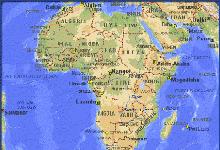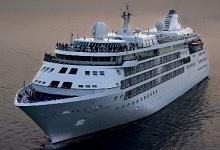Recently Viewed Cruises
- Wind, Voyage 2336 ex Las Palmas to Cape TownAdd to favourites
- Saga Sapphire, Africa & Solar Eclipse ex Southampton ReturnAdd to favourites
- Silver Explorer, Voyage 7308 ex Accra to DakarAdd to favourites
- Whisper, Voyage 4306 ex Port Louis to Cape TownAdd to favourites
- Silver Explorer, Voyage 7307 ex Cape Town to AccraAdd to favourites
- Royal Caribbean International raises the bar
- Classy Astor fills gap in market
- Oceanic Discoverer
- Ab Fab Oosterdam
- Catch up on Cruising: Latest cruise news in bite size
- Frequently Asked Questions
-
Wind, Voyage 2336 ex Las Palmas to Cape Town
Nights 18 Ship Silver Wind Star Rating 
Departs Gran Canaria (Las Palmas), Canary Islands Sailing 2013: 3 Dec Ports of Call Gran Canaria (Las Palmas), Porto Novo, Cape Verde Islands, Dakar, Takoradi, Walvis Bay, Luederitz, Cape Town Select a sailing date for approximate pricing.
Prices are per person, twin share. When booking please check current cruise fare and inclusions. Prices are indicative only, subject to currency fluctuations and may change at any time without notice.
18 Night Cruise sailing from Las Palmas to Cape Town aboard Silver Wind.
Silver Wind, launched in 1995, was the second ship introduced by Silversea. Much like its sister ship, Silver Cloud, the Wind is a shining example of intimate Italian cruising. Fewer guests, combined with more space and Silversea's signature six-star personalised service make for the ultimate sailing experience. This elite vessel is as a grand hotel, as gracious as a long-time friends' home. Each all ocean-view suite provides a sumptuous retreat. Each public space is intimate yet inviting. It's a warm feeling of home upon the seas of the earth.
Aboard Silver Wind you will find a most accommodating place to view our world. Whether it's delicious onboard diversions, world-class cuisine, memorable dining venues or staying connected from anywhere, Silversea's impeccable standards apply to every detail of your voyage.
Highlights of this cruise:
Las Palmas
The seven main islands that comprise the Canary Archipelago lie scattered in the Atlantic Ocean off the west coast of Morocco. Often called the "Fortunate Islands," the name refers to the islands' geographic location and marvellous climate, which accounts for spring-like weather all year round. Of volcanic origin, the islands boast a bounty of natural treasures, including beautiful beaches, verdant forests, majestic mountains and rolling dunes. In addition to modern towns and resorts, the islands feature cultural remnants of Guanches, the original inhabitants conquered by the Spaniards in the 15th century.
Gran Canaria is the third largest island in the archipelago after Tenerife and Fuerteventura. Almost circular in shape, the island is often referred to as a "miniature continent" due to its great variety of scenery. Generally divided into the two distinct climatic areas of the arid south and the more humid north, the island features diverse natural attractions including desert-like landscapes, golden dunes, lush vegetation, soaring mountains and rugged ravines, as well as the awe-inspiring cliffs of Puerto de las Nieves.
Las Palmas, the largest city in the archipelago with a population of about 350,000, is situated on the northeast tip of the island. As befits a modern, active city, Las Palmas features several museums, lovely parks, beaches, and a lively nightlife, all perfect diversions for the many visitors who flock here. In the southern part of the city is Vegueta, the noble, peaceful historical district of Las Palmas. Here visitors find stately old houses with balconies facing narrow streets and sheltered squares. Many of the city's most important attractions are located here, including the Gothic neo-classical church and Columbus House, the residence of the first governors of the island. From the south, the city hugs the coast up to the bustling areas of Puerto de la Luz and Santa Catalina, the hub of the city.
Las Palmas also serves as the gateway to the scenic interior and to the southern part of the island with its resorts and popular beaches, including the bustling Playa del Ingles and Maspalomas with its sand dunes.
Dakar
Senegal is the western-most nation in Africa, stretching out into the Atlantic and bordered by Mauritania, Mali, Guinea and Guinea-Bissau. Curiously, the tiny nation of Gambia lies entirely within Senegal's borders. As with most of Africa, Senegal was touched by the slave trade; traces of this sad history remain just offshore, on Goree Island.
Dakar, capital of the Republic of Senegal, is a historic collection of 19 communes with a population of just over 1 million in the central area. Although seemingly trapped in an apparent economic struggle for its life, the city is a mix of striking contemporary architecture set off by historical colonial buildings. If you can look past the obvious drudgery, trash, and toil of the community, it reveals to you a vibrant city full of galleries, boutiques and street vendors offer everything from paintings, sculptures and crafts to colourful clothing and imported goods.
Walvis Bay
Formerly a whaling station, Walvis Bay has become the principal port of entry into Namibia. In 1795, while occupied by the British, Walvis Bay was turned into a naval base in order to monitor and intimidate the empire's European rivals during the so-called "scramble for Africa". When Namibia gained independence in 1990, Walvis Bay and the surrounding enclave remained part of South Africa until February 28, 1994. On this date, the enclave was transferred to Namibian control, ending a long disputed claim between the two countries.
The town is built for the harbour, with numbered streets forming an unexciting, but easily navigable grid around it. The city centre can be covered on foot. Of special note are the municipal buildings, decorated with attractive wood carvings from Namibia's Kavango region. Exhibits at the local museum illustrate the history of the town and the indigenous Topnaar people. The lagoon on the outskirts of Walvis Bay is home to a bird sanctuary. Flocks of flamingos and pelicans feed here in the nutrient-rich water. The lagoon also supports an important salt industry.
The resort town of Swakopmund lies 24 miles (38 km) north of Walvis Bay. It was under German domination until 1915. With Walvis Bay under British control, the German authorities tried to develop their own interests by establishing Swakopmund as a port, but without much success. When German rule was surrendered to South Africa, all trading returned to Walvis Bay. Before independence, Afrikaans, English and German were the official languages. Following independence, English became the official language, with Bantu and Khoi-San the main ethnic language groups.
Walvis Bay is a good starting point for excursions into the desert and dune regions, offering visions of unspoiled landscapes, compelling beauty and a feeling of unconfined space.
Cape Town
Sheltered beneath the familiar shape of Table Mountain, the historic city of Cape Town is instantly recognizable, and few cities in the world possess its beauty and style. A stroll through the lovely city center reveals Cape Town's three centuries as the sea link between Europe and the East. Elegant Cape Dutch buildings, characterized by big whitewashed gables, often a thatch roof, and shuttered windows, abut imposing monuments to Britain's imperial legacy. In the Bo-Kaap neighborhood the call to prayer echoes from minarets while the sweet tang of Malay curry wafts through the cobbled streets. And everywhere, whether you're eating outdoors at one of the country's best restaurants or sipping wine atop Table Mountain, you sense-correctly-that this is South Africa's most urbane, civilized city.







